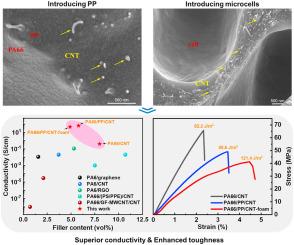工程聚酰胺66基复合材料具有优异的导电性和增强的韧性
IF 7.7
2区 材料科学
Q1 MATERIALS SCIENCE, COMPOSITES
引用次数: 0
摘要
采用易熔体共混和超临界CO2发泡法制备了具有超高导电性和低渗透阈值的聚酰胺66 (PA66)基复合材料。拉伸试验证实,“海岛”结构PA66/PP共混物中聚丙烯(PP)的最佳含量为20 wt%,可保证PA66相的结构完整性。电导率测量表明,添加PP将复合材料的渗透阈值降低到4.1 vol%,同时将最大电导率提高到62.1 S/cm,显示出与大多数先前报道的pa基CPCs相关的优越电导率性能。电导率的显著提高主要归因于碳纳米管在复合材料中的选择性位置和PP引入引起的结晶行为的变化。此外,由于马来酸酐接枝PP的界面相容性,PP的加入提高了PA66/PP/CNT的拉伸韧性。此后,通过超临界co2辅助发泡技术,成功地将微孔结构集成到PA66/PP/CNT复合材料中。同时实现了减轻重量和增强韧性,并显著降低了渗透阈值,提高了复合材料在低碳纳米管负载下的导电性。这项工作为轻质、高导电性和高韧性高性能cpc的结构设计提供了深入的见解。本文章由计算机程序翻译,如有差异,请以英文原文为准。

Engineered polyamide 66-based composites towards superior electrical conductivity and enhanced toughness
Polyamide 66 (PA66)-based composites with ultra-high conductivity and low percolation threshold as well as enhanced toughness were fabricated via facile melt blending and supercritical CO2 foaming. The tensile tests confirmed the optimal polypropylene (PP) content of 20 wt% in “sea-island” structured PA66/PP blends to guarantee the structural integrity of the PA66 phase. The conductivity measurements manifested that adding PP lowered the percolation threshold of the composites to 4.1 vol% and simultaneously increased the maximum conductivity to 62.1 S/cm, demonstrating superior conductivity performance related to most previously reported PA-based CPCs. The significant enhancement in conductivity could be mainly ascribed to the selective location of CNT in the composites and the changes in crystallization behavior induced by PP introduction. Additionally, PP incorporation improved the tensile toughness of the PA66/PP/CNT due to the interfacial compatibility of maleic anhydride-grafted PP. Thereafter, the microcellular architecture was successfully integrated into PA66/PP/CNT composites through supercritical CO2–assisted foaming technique, enabling simultaneous attainment of weight reduction and toughness enhancement as well as remarkably reduced percolation threshold and elevated the conductivity of the composites at low CNT loading. This work offers an in-depth insight into the architectural design for high-performance CPCs with light weight, high conductivity and good toughness.
求助全文
通过发布文献求助,成功后即可免费获取论文全文。
去求助
来源期刊

Composites Communications
Materials Science-Ceramics and Composites
CiteScore
12.10
自引率
10.00%
发文量
340
审稿时长
36 days
期刊介绍:
Composites Communications (Compos. Commun.) is a peer-reviewed journal publishing short communications and letters on the latest advances in composites science and technology. With a rapid review and publication process, its goal is to disseminate new knowledge promptly within the composites community. The journal welcomes manuscripts presenting creative concepts and new findings in design, state-of-the-art approaches in processing, synthesis, characterization, and mechanics modeling. In addition to traditional fiber-/particulate-reinforced engineering composites, it encourages submissions on composites with exceptional physical, mechanical, and fracture properties, as well as those with unique functions and significant application potential. This includes biomimetic and bio-inspired composites for biomedical applications, functional nano-composites for thermal management and energy applications, and composites designed for extreme service environments.
 求助内容:
求助内容: 应助结果提醒方式:
应助结果提醒方式:


